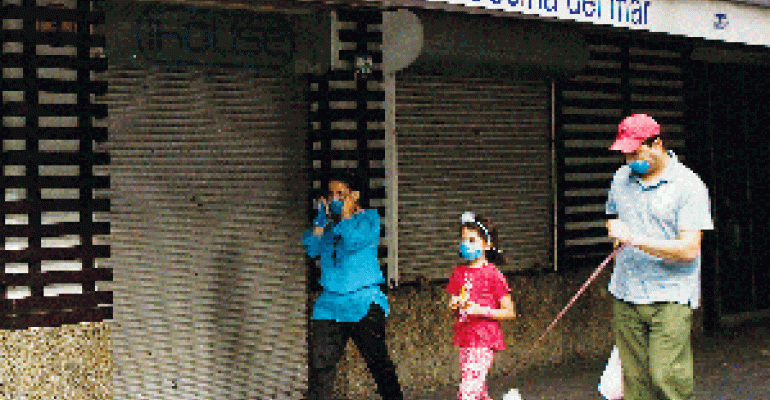ATLANTA Even as Mexico City's government ordered all the city's restaurants to suspend dine-in service over a growing swine flu outbreak, observers say there is no discernible impact yet to the U.S. restaurant industry.
U.S. restaurant companies have not yet commented on an impact to sales, and such a phenomenon would not likely be apparent until public companies report second-quarter results in July, Robert Derrington, an analyst with Morgan Keegan, said in a research note released Tuesday. The fear, however, is that growing concern over the outbreak could keep more people from enjoying travel and leisure activities where people gather, such as eating out, he said.
In Mexico City, Bloomberg reported that the government ordered all 35,000 restaurants in the capital to close their dine-in service through May 5 in a bid to contain a flu outbreak. Restaurants reportedly may continue to sell food for take-out and delivery. A number of U.S. restaurant chains have already closed locations in the area, according to reports.
Derrington predicted that a slowdown in U.S. business would be most apparent in restaurants located in states that border Mexico, where swine flu is suspected in 149 deaths. He also said that sales at full-service casual-dining eateries were more likely to be affected than those at fast feeders, where drive-thrus could limit contact with other people.
He speculated that swine flu concerns would further push down the price of pork.
“Pork future prices have been pressured recently -- down 4 percent [Monday] -- by concern of consumers shunning pork products in fear of flu,” Derrington wrote. “The flu, which is not related to hogs or transmitted by pork, has caused several countries including Russia and China to limit importation of pork from several U.S. states.”
To keep operators updated on the swine flu situation, the National Restaurant Association created a web page, http://www.restaurant.org/swineflu/, with links to the latest information from the government as well as answers to frequently asked questions.
As of Tuesday, the number of confirmed U.S. swine flu cases swelled to 64 and international health watchdogs raised alert levels tied to the infectious bug, prompting the acting director of the Centers for Disease Control and Prevention to urge employers to prepare for possible workforce disruptions.
“It’s time for businesses to review their plans and think about what they would do if some of [their] workers couldn’t come to work," Dr. Richard Besser of the CDC said during a press briefing Monday.
Employers, he continued, must ask themselves “How would my business function?” if multiple employees were forced to stay home because they were ill or their children were ill.
The Geneva-based World Health Organization on Monday raised the level of its swine influenza pandemic alert from phase 3 to phase 4 of six phases. It said the action indicated that "the likelihood of a pandemic has increased, but not that a pandemic is inevitable.”
“There has been tremendous planning that’s been going on around the country over the past number of years,” Besser said of federal, state and local activity related to dealing with a possible pandemic. “It’s time for people to review those plans and think about what they should do.”
He said the federal government and state and local public health officials “continue to approach this investigation and our control efforts aggressively.”
“We want to take bold action to minimize the impact on people’s health from this infection,” he said.
The federal government has begun distributing testing kits and other resources to state health departments so they can better detect and track swine flu cases and it has released 25 percent of the country’s stockpile of flu vaccines, Besser explained.
As of Tuesday afternoon, the CDC reported 64 confirmed cases of swine flu in the United States, and said the outbreak so far is limited to five states: California, Kansas, New York, Ohio and Texas.
Besser said late Monday that all confirmed U.S. cases have been relatively mild, with just one brief hospitalization. That compares with 26 confirmed illnesses and seven deaths in Mexico. The CDC leader said investigators “need to know why we’re seeing a different disease spectrum in Mexico than we’re seeing here.”
He cautioned: “I wouldn’t rest on the fact that we have only seen cases in this country that are less severe. As we continue to look I expect that we’ll see additional cases and I expect the spectrum of disease will expand.”
On Monday, the CDC issued a travel advisory to U.S. citizens urging them to delay all “non-essential travel” to Mexico because of rising incidences there of swine flu and severe respiratory illness. That followed a Sunday declaration by U.S. government officials that the swine-flu outbreak is a public health emergency.
Janet Napolitano, secretary of the U.S. Department of Homeland Security, reportedly characterized the declaration as “standard operating procedure” issued for such other recent events as flooding in the Midwest, and suggested that it be considered a “declaration of emergency preparedness.”
World Health Organization officials on Monday said their decision to up the pandemic alert level was based primarily on epidemiological data demonstrating human-to-human transmission and the ability of the virus to cause community-level outbreaks.
Given the widespread presence of the virus, Dr. Margaret Chan, WHO director-general, said she considered that containment of the outbreak is not feasible. Besides the United States and Mexico, Canada, New Zealand, the United Kingdom, Spain and Israel had confirmed swine flu cases as of Tuesday.
Afull transcript of the CDC’s Monday press briefing, as well as an audio recording of the session, is available at http://www.cdc.gov/media/transcripts/2009/t090427.htm. The agency’s home page on swine flu developments is at http://www.cdc.gov/swineflu/.
Contact Alan J. Liddle at [email protected].





